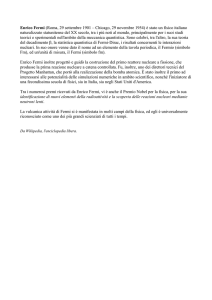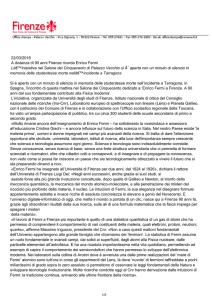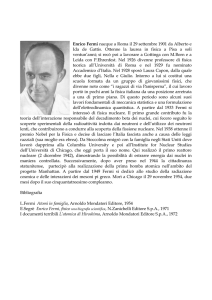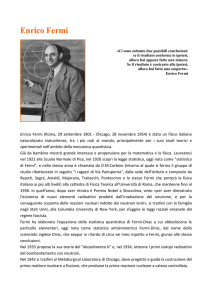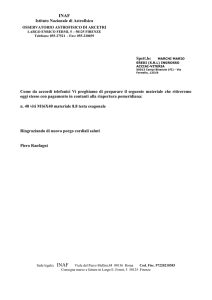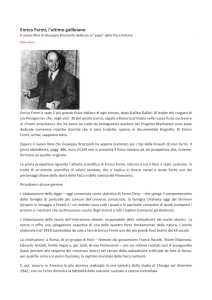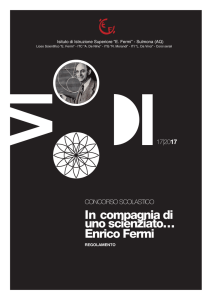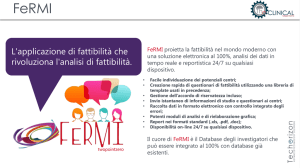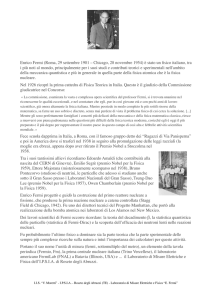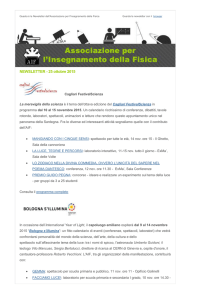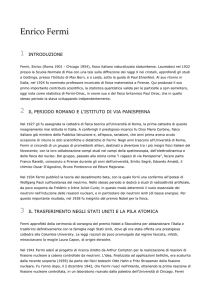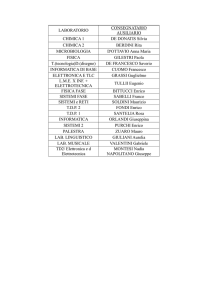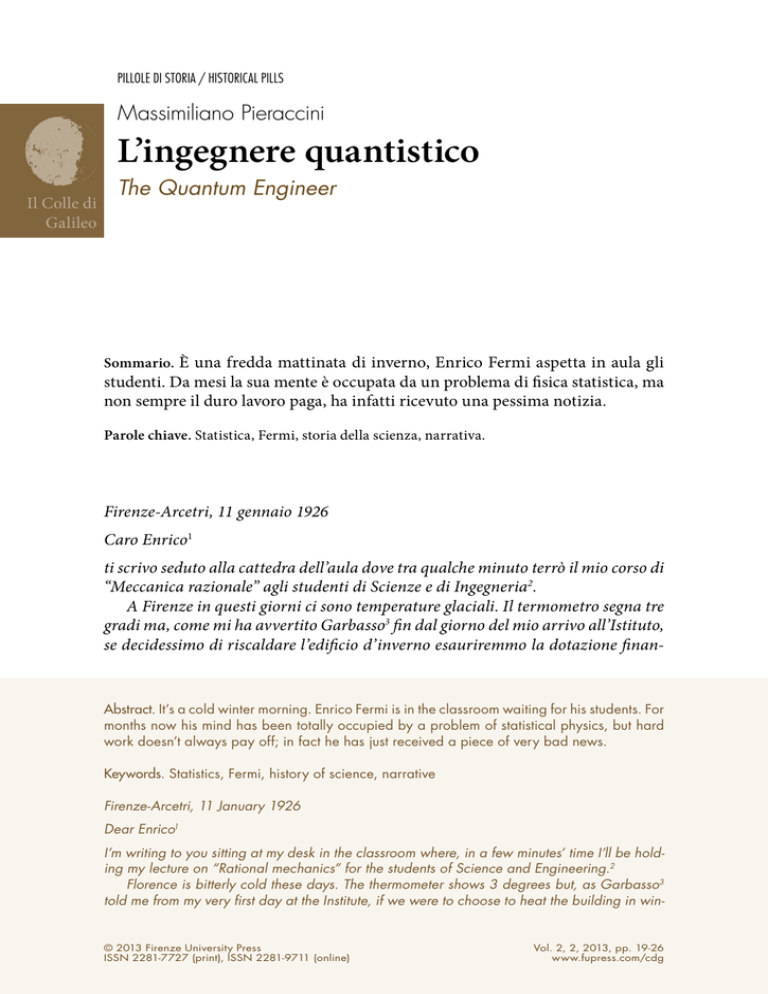
PILLOLE DI STORIA / HISTORICAL PILLS
Massimiliano Pieraccini
L’ingegnere quantistico
Il Colle di
Galileo
The Quantum Engineer
Sommario. È una fredda mattinata di inverno, Enrico Fermi aspetta in aula gli
studenti. Da mesi la sua mente è occupata da un problema di fisica statistica, ma
non sempre il duro lavoro paga, ha infatti ricevuto una pessima notizia.
Parole chiave. Statistica, Fermi, storia della scienza, narrativa.
Firenze-Arcetri, 11 gennaio 1926
Caro Enrico1
ti scrivo seduto alla cattedra dell’aula dove tra qualche minuto terrò il mio corso di
“Meccanica razionale” agli studenti di Scienze e di Ingegneria2.
A Firenze in questi giorni ci sono temperature glaciali. Il termometro segna tre
gradi ma, come mi ha avvertito Garbasso3 fin dal giorno del mio arrivo all’Istituto,
se decidessimo di riscaldare l’edificio d’inverno esauriremmo la dotazione finan-
Abstract. It’s a cold winter morning. Enrico Fermi is in the classroom waiting for his students. For
months now his mind has been totally occupied by a problem of statistical physics, but hard
work doesn’t always pay off; in fact he has just received a piece of very bad news.
Keywords. Statistics, Fermi, history of science, narrative
Firenze-Arcetri, 11 January 1926
Dear Enrico1
I’m writing to you sitting at my desk in the classroom where, in a few minutes’ time I’ll be holding my lecture on “Rational mechanics” for the students of Science and Engineering.2
Florence is bitterly cold these days. The thermometer shows 3 degrees but, as Garbasso3
told me from my very first day at the Institute, if we were to choose to heat the building in win-
© 2013 Firenze University Press
ISSN 2281-7727 (print), ISSN 2281-9711 (online)
Vol. 2, 2, 2013, pp. 19-26
www.fupress.com/cdg
20
Massimiliano Pieraccini
ziaria annuale in meno di un mese e allora, veramente, non avremmo di che fare
il più semplice esperimento di Fisica.
Stamattina mi sono alzato prima dell’alba e ho passeggiato a lungo per le strade deserte della città prima di arrivare in Piazza San Marco4. Sentivo il bisogno
di schiarirmi le idee: l’articolo di Pauli su Z. Physik5 mi ha sconvolto e depresso.
Avevo cominciato a riflettere sulla questione dell’entropia di un gas perfetto fin
dal mio soggiorno a Leida6, ma continuava a sfuggirmi una qualche regola generale su come contare gli atomi nello spazio delle fasi. Ed ora Pauli l’ha trovata. Una regola semplicissima, ovviamente, e io mi sento uno stupido completo.
A cosa è servito dedicare ogni mia energia alla Fisica per tutti questi anni? Forse è il coraggio che mi manca. Dovevo osare, formulare quella maledetta regola,
e invece l’ha fatto lui. Quando l’ho incontrato a Gottinga7, quasi non mi voleva
stringere la mano, troppo impegnato a non voler capire la Fisica con Born, Heisenberg e Jordan. Perché ciò di cui ragionano loro non è più Fisica, è zoologia dei
termini spettroscopici o, peggio, pura filosofia! E quella è una lingua che proprio
non riesco a comprendere. Pauli una sera, più ubriaco del solito, mi ha chiamato
“ingegnere quantistico”. E forse ha ragione lui. Non sono adatto all’astrazione di
questa nuova Fisica. Io sono e rimango il figlio di un ferroviere, un bambino che
si è rifugiato nello studio della matematica e della Fisica per non pensare ai lutti
della propria famiglia8.
Scusami, caro amico mio, per questo sfogo. Vorrei tu fossi qui. Come al solito
mi sento molto solo. Nessuno qui capisce qualcosa di Fisica moderna: a Firenze la
scienza è ostinatamente ferma al 18209. Rasetti10 è l’unico con cui posso parlare. Ma
ter we’d finish the yearly allowance in less than a month, and then we genuinely would not
have the wherewithal to do even the simplest physics experiment.
This morning I rose before dawn and I walked at length through the deserted streets of the
city before reaching Piazza San Marco.4 I felt the need to clear my mind: I was upset and depressed by Pauli’s article in Z. Physik.5 I had begun to reflect on the question of the entropy of
a perfect gas since my stay in Leiden,6 but a general rule about how to count the atoms in the
space of the phases continued to elude me. And now Pauli has found it! The simplest of rules,
obviously, and I feel like a complete idiot. What is the point in my having devoted all my energy to physics for all these years? Perhaps what I am lacking is courage. I should have dared,
formulated that blessed rule, instead he did it. When I met him in Göttingen,7 he seemed almost reluctant to shake hands with me, so busy was he with failing to understand physics along
with Born, Heisenberg and Jordan. Because what they spend their time discussing isn’t physics
any more at all, it’s zoology of spectroscopic terms or, worse still, pure philosophy! And that’s
a language that I simply can’t understand. One evening when he was even more drunk than
usual, Pauli called me a ‘quantum engineer’. Who knows? Perhaps he’s right. The abstraction
of this new physics is not for me. I’m the son of a railwayman and I always will be: a boy who
took refuge in the study of mathematics and physics to take his mind off the bereavements in
his own family.8
My dear friend, forgive me for this outburst. I so wish you were here. As usual I feel very
alone. No-one here understands anything about modern physics: in Florence science obstiMassimiliano Pieraccini
L’ingegnere quantistico
è così strano. Non ha ambizioni né veri interessi in Fisica. Sparisce per settimane e
torna con collezioni di foglie e minerali. Passa le giornate a cucinare piatti esotici e
parlare degli usi e della filosofia indiani. Ma quando è in laboratorio fa cose strabilianti, che mi fanno ammutolire per ingegno e fantasia. Se non ci fosse lui, sarei
veramente perso in questo Istituto così misero e male attrezzato. È una ben triste
condizione la mia: superato nella teoria da un ubriacone tedesco e nella pratica
dal mio stesso compagno di laboratorio.
Se almeno si risolvesse la questione del concorso! Prima tutto era fermo perché
non uscivano le nuove norme ministeriali. Quando sono state pubblicate è venuto
fuori il problema della commissione. Corbino11 e Garbasso dovrebbero essere sicuri, ma certo lo stesso non si può dire per gli altri membri. Maiorana12, Somigliana e
Maggi sono i più probabili13, ma non voglio neanche pensare all’ipotesi Lo Surdo14!
Intanto ho fatto domanda anche per Fisica matematica a Cagliari15. Con tutta questa incertezza sul concorso di Roma, meglio avere un fucile con due canne, benché
non mi sorrida particolarmente l’idea di andare a finire nelle isole.
Malgrado lo sconforto, ma forse a maggior ragione, in questi giorni ho lavorato intensamente all’idea di Pauli (che certo avrei potuto avere io, se solo avessi
avuto ancora un po’ di tempo) applicandola alla quantizzazione di un gas perfetto
monoatomico. Vorrei riuscire a presentare un lavoro alla riunione dell’Accademia
dei Lincei che si terrà tra qualche giorno16. Sono convinto che le molecole di un gas
possano essere trattate in modo quantistico ed ora, dopo l’intuizione di Pauli, posso forse calcolarne la statistica. Magari ne viene qualcosa di buono da pubblicare
anche su Zeitschrift für Physik 17.
nately came to a standstill in 1820.9 Rasetti10 is the only one I can talk to. But he’s such a queer
fish. He has no ambitions, nor any real interest in physics. He disappears for weeks on end
and comes back with collections of leaves and minerals. He spends his time preparing exotic
dishes and talking about Indian customs and philosophy. But when he’s in the laboratory he
does the most amazing things, with an ingenuity and imagination that leave me speechless. If
it were not for him I would be truly lost in this Institute, so miserable and poorly equipped. Mine
is indeed a very unhappy condition: surpassed in theory by a German drunk and in practice
by my own laboratory companion.
If at least the problem of the competition could be resolved! First it was all held up because
the new Ministerial rules had not been issued. And then, when they were published, the problem of the selection committee came up. Corbino11 and Garbasso ought to be certain, but we
can’t say the same about the others members. Majorana,12 Somigliana and Maggi seem the
most likely,13 but I don’t even want to contemplate the possibility of Lo Surdo!14 In the meantime
I’ve also applied for the mathematical physics competition at Cagliari.15 With all this uncertainty about the Rome competition I feel it’s advisable to have another string to one’s bow, even
though the prospect of ending up on the islands does not particularly attract me.
Despite my dejection, or perhaps even because of it, I’ve been working intensely on Pauli’s
idea over the last few days (and I’d certainly have come to the same conclusion myself if I’d
had just a little more time), applying it to the quantization of a perfect monoatomic gas. I want
to be able to present a paper at the meeting of the Accademia dei Lincei which will be held in
The Quantum Engineer
21
22
Massimiliano Pieraccini
Saluti affettuosi a te e alla tua mamma e arrivederci a presto.
Enrico Fermi
P.S. (13 gennaio 1926) In questi giorni sono stato troppo impegnato nei calcoli della
mia statistica e non ho avuto il tempo di spedire questa lettera. Rileggendola, credo
proprio che non la spedirò più18.
Postilla
Il periodo fiorentino di Fermi è forse il meno noto della vita del grande scienziato, ma è fondamentale per capirne il carattere e la formazione. A questo
proposito di grande interesse sono le lettere che Fermi ha scambiato fin dal
1917 con l’amico di infanzia Enrico Persico (riportate integralmente in Emilio Segrè,“Enrico Fermi, fisico”, Zanichelli, 1971). Questa corrispondenza è una
preziosa finestra sulla personalità di un uomo di carattere schivo, ben poco incline all’espressione diretta dei propri sentimenti. Purtroppo sono disponibili
solo otto lettere spedite da Firenze e certamente sarebbe una grande scoperta
trovarne una nona, magari scritta proprio nei giorni cruciali della scoperta che
avrebbe rivoluzionato la storia della tecnologia. Troppo bello per essere vero,
ovviamente. Ma alle lacune della documentazione storica, può sempre sopperire la fantasia del romanziere.
a few days’ time.16 I am convinced that the atoms of a gas can be quantistically treated, and
after Pauli’s intuition I can calculate the statistics of it. Maybe something good may come of it
that could even be published in the Zeitschrift für Physik. 17
Affectionate greetings to you and your mother, and hoping to see you soon.
Enrico Fermi
P.S. (13 January 1926) Over the last few days I’ve been so busy with the calculations of my
statistics that I haven’t had time to post this letter. Reading it over, I really don’t think I shall
send it after all.18
Afterword
Fermi’s time in Florence is possibly the least known period in the life of the great scientist, but
it is fundamental to an understanding of his character and his education. In this respect, the
letters that Fermi exchanged from 1917 on with his childhood friend Enrico Persico are of the
greatest interest (included in their entirely in the book by Emilio Segrè, Enrico Fermi, Physicist, The University of Chicago Press, Chicago, 1970). This correspondence opens a fascinating window on the personality of a man of reserved character, not at all prone to expressing
his feelings openly. Unfortunately only eight letters written from Florence are available, and
Massimiliano Pieraccini
L’ingegnere quantistico
Massimiliano Pieraccini è nato ad Arezzo nel 1968. Laureato in fisica, è professore
associato di Elettronica presso l’Università di Firenze. Si occupa di radar e microonde, ma nel tempo libero scrive narrativa. Nel 2011 ha pubblicato con Rizzoli un
romanzo dal titolo “L’anomalia” che ibrida scienza e thriller. Per “La Repubblica”
ha scritto un racconto storico dal titolo “Capitano di vascello”.
Note
Enrico Persico, compagno di scuola di Enrico Fermi a Roma, rimase in costante contatto epistolare con l’amico per molti anni. Nel 1927 Persico vincerà la
cattedra di Fisica Teorica proprio a Firenze.
2 Dal 1924 era stato istituito il biennio propedeutico di Ingegneria presso la
Facoltà di Scienze Fisiche e Naturali della Regia Università di Firenze.
3 Antonio Garbasso, all’epoca direttore dell’Istituto di Fisica della Regia
Università degli Studi di Firenze, sindaco di Firenze e senatore del Regno d’Italia.
4 Le lezioni si tenevano in via Piazza Marco, 2 oggi sede del Rettorato. E.F. era
domiciliato in Via del Pian dei Giullari 63 (oggi via Guglielmo Righini, 2) sul
colle di Arcetri, in uno stabile dell’Università nei pressi dell’Istituto di Fisica.
Piazza San Marco, nel centro storico di Firenze, dista da Arcetri circa 4 Km.
5 Uber den Zusammenhang des Abschlusses der Elektronengruppen im atom mit
der Komplexstruktur der Spektren, “Zeitschrift fur Physik”, Vol 31, pp. 765-783.
In questo articolo Wolfang Pauli formula l’enunciato, oggi noto come “Principio
di esclusione di Pauli”, che valse al suo autore il Premio Nobel nel 1945.
1 it would undoubtedly be a an amazing coup to find a ninth one, perhaps written on the very
days in which he was working on the crucial discovery that was to revolutionise the history
of technology. But that would be asking for too much, obviously. Nevertheless, there is nothing to stop the gaps of historic documentation being filled by the imagination of the novelist.
Massimiliano Pieraccini was born in Arezzo in 1968. He graduated in Physics and is now Associate Professor of Electronics at the University of Florence. He deals with radar and microwaves, and in his spare time writes fiction. In 2011 he published with Rizzoli a novel entitled
L’anomalia, a hybrid of science and thriller. For La Repubblica he has written a historic short
story entitled Capitano di vascello.
Note
Enrico Persico, who was at school with Enrico Fermi in Rome, maintained a constant correspondence with his friend for many years. In 1927 Persico was appointed to the chair of
Theoretical Physics in Florence.
2 Since 1924 the two-year preparatory course in Engineering had been established in the Faculty of Physical and Natural Sciences of the Royal University of Florence.
3 Antonio Garbasso, at the time Director of the Institute of Physics of the Royal University of
Florence, Mayor of Florence and Senator of the Kingdom of Italy.
1 The Quantum Engineer
23
24
Massimiliano Pieraccini
Nel 1924, E.F. trascorse alcuni mesi a Leida ospite del prof. Paul Ehrenfest, che
incoraggiò moltissimo il giovane scienziato spingendolo a approfondire i suoi
studi di spettroscopia e meccanica statistica.
7 Nell’inverno del 1923 E.F, grazie a una borsa di studio del Ministero dell’Istruzione, visitò l’istituto di Max Born a Gottinga, all’epoca uno dei maggiori centri
di ricerca del mondo, dove stava compiendosi la rivoluzione scientifica di quegli
anni. Disgraziatamente sembra che E.F. non riuscisse ad affiatarsi in questo ambiente straordinario né a interagire con i suoi coetanei.
8 Il fratello maggiore di E.F. muore all’età di 15 anni durante un’anestesia, la
tragedia sconvolse la madre che muta di carattere manifestando frequenti crisi
depressive. La morte della madre nove anni dopo fu un ulteriore grave colpo.
E.F. rimase segnato per sempre da questi eventi che lo resero taciturno e poco
incline a esprimere la proprie emozioni.
9 Malgrado l’evidente ritardo in campo scientifico di Firenze in quegli anni, l’anno successivo con la nomina di Enrico Persico a professore di Fisica Teorica,
l’istituto fiorentino diverrà presto uno dei più avanzati centri di ricerca nel campo della nascente Fisica quantistica, in stretta collaborazione con il gruppo di
Roma. Per alcuni anni gli atenei di Roma e Firenze saranno gli unici in Italia a
impartire insegnamenti di fisica moderna.
10 Franco Rasetti, compagno di università di E.F., lo seguì a Firenze e poi a Roma.
Fu uno dei più importanti protagonisti del gruppo di via Panisperna. Nel 1939,
in seguito alla situazione politica italiana, emigrò in Canada. Non collaborò mai
allo sforzo bellico degli Alleati e progressivamente passò agli studi naturalistici,
6 The lessons were held in Via Piazza Marco, 2 now premises of the Vice Chancellor’s office.
Enrico Fermi lived in Via del Pian dei Giullari 63 (now Via Guglielmo Righini, 2) on the hill of
Arcetri, in a building belonging to the University close to the Institute of Physics. Piazza San
Marco, in the old city centre of Florence, is about 4 km from Arcetri.
5 Uber den Zusammenhang des Abschlusses der Elektronengruppen im atom mit der Komplexstruktur der Spektren, “Zeitschrift fur Physik”, Vol 31, pp. 765-783. In this article Wolfang Pauli
formulated the assertion, now known as the “Pauli exclusion principle” that won its author the
Nobel Prize in 1945.
6 In 1924, Fermi spent several months in Leiden as the guest of Professor Paul Ehrenfest, who
offered great encouragement to the young scientist, urging him to pursue his studies in spectroscopy and statistical mechanics.
7 In the winter of 1923, thanks to a scholarship from the Ministry of Education, Fermi visited
the Institute of Max Born in Göttingen, at the time one of the most important research centres
in the world, where the scientific revolution of those years was taking place. Unfortunately, it
seems that Fermi was incapable of fitting into this environment or of getting on with his peers
and interacting with them.
8 Fermi’s elder brother died under anaesthetic at the age of 15; his mother was completely unhinged by the tragedy, which altered her character, and she became prone to frequent bouts
of depression. The death of his mother nine years later was another harsh blow. Fermi was permanently marked by these events, which made him taciturn and loath to express his feelings.
4 Massimiliano Pieraccini
L’ingegnere quantistico
guadagnandosi una discreta notorietà scientifica come paleontologo.
11 Orso Mario Corbino, all’epoca professore di Fisica Sperimentale, senatore
del Regno, già titolare dei dicasteri della Pubblica Istruzione e dell’Economia
Nazionale. Con la chiamata di E.F. a Roma, Corbino sarà il principale organizzatore e protettore del gruppo dei “ragazzi di Via Panisperna” che per una breve
stagione portò la fisica italiana all’apice della scienza mondiale.
12 Quirino Majorana, zio di Ettore Majorana il grande fisico teorico del gruppo
di Via Panisperna, scomparso in circostanze misteriose nel 1938.
13 Dopo varie vicissitudini, la composizione finale della commissione fu:
Corbino, Garbasso, Cantone, Majorana, Maggi.
14 Antonino Lo Surdo, professore di Fisica Sperimentale a Roma, avversario politico di Garbasso e di E.F. In seguitò aderì entusiasticamente ai programmi politici e raziali del regime, rigettando gli sviluppi della fisica “giudea”.
15 La commissione del concorso di Cagliari, i cui atti furono pubblicati nel marzo 1926, giudicò E.F. maturo per la cattedra, ciò nonostante quando si venne a
formare la graduatoria per la terna non si raggiunse l’unanimità. E.F. visse ciò
come una profonda ingiustizia e per molti anni non dimenticò né il concorso né
i giudici.
16 Sulla quantizzazione del gas perfetto monoatomico, “Atti dell’Accademia dei
Lincei” (1926), 3, pp. 145-149.
17 Zur Quantelung des idealen einatomigen Gases, “Zeitschrift für Physik” (1926),
36, pp. 902-912. Si tratta di uno dei maggiori contributi di E.F. Per la prima volta
si introduce una formulazione quantistica che descrive il comportamento degli
9 Despite the fact that Florence was clearly lagging behind in the scientific field at the time,
after the election of Enrico Persico as Professor of Theoretical Physics the following year the
Florentine Institute rapidly became one of the research centres in the vanguard of the nascent
field of Quantum Physics, in close collaboration with the Rome group. For several years Florence and Rome were the only universities in Italy to teach modern physics.
10 Franco Rasetti, a university companion of Fermi’s, followed him to Florence and then to Rome.
He was one of the most important exponents of the group of Via Panisperna. In 1939, the Italian political situation forced him to emigrate to Canada. He never collaborated in the war efforts of the Allies and progressively shifted his interests towards naturalistic studies, earning a
considerable scientific reputation as a palaeontologist.
11 Orso Mario Corbino, at the time Professor of Experimental Physics, Senator of the kingdom,
and former Minister of Education and of the Economy. When Fermi was called to Rome, Corbino was the main organiser and protector of the “lads of Via Panisperna” which for a short and
glorious season brought Italian Physics to the apex of world science.
12 Quirino Majorana, uncle of Ettore Majorana the great theoretical physicist of the Via Panisperna group, who disappeared in mysterious circumstances in 1938.
13 After various vicissitudes the final composition of the committee was: Corbino, Garbasso,
Cantone, Majorana and Maggi.
14 Antonino Lo Surdo, Professor of Experimental Physics at Rome, political adversary of Garbasso and Fermi. He subsequently subscribed enthusiastically to the political and racial pro-
The Quantum Engineer
25
26
Massimiliano Pieraccini
atomi di un gas, oggi universalmente nota come “Statistica Fermi-Dirac”. La moderna elettronica dei semiconduttori si basa su questo risultato, come ben sanno
gli studenti di ingegneria di tutto il mondo.
18 In effetti questa lettera non è compresa nella corrispondenza che Enrico
Persico mise a disposizione degli studiosi dopo la morte di E.F. nel 1954.
grammes of the regime, rejecting the developments of “Jewish” physics.
15 The selection committee of the Cagliari competition, the proceedings of which were published in 1926, considered Fermi qualified for the chair. Despite this, unanimity was not obtained in the ranking for the shortlist. Fermi considered this a profound injustice, and for many
years the memory of both the competition and the judges continued to rankle.
16 Sulla quantizzazione del gas perfetto monoatomico, “Proceedings of the Accademia dei
Lincei” (1926), 3, pp. 145-149.
17 Zur Quantelung des idealen einatomigen Gases, “Zeitschrift für Physik” (1926), 36, pp. 902912. This was one of Fermi’s most important papers. It introduced for the first time a quantum
formulation describing the behaviour of the atoms of a gas , now universally known as FermiDirac Statistics. As students of engineering all over the world are well aware, modern semiconductor electronics is based on this result.
18 In effect this letter is not comprised in the correspondence that Enrico Persico made available to scholars after Fermi’s death in 1954.
Massimiliano Pieraccini

